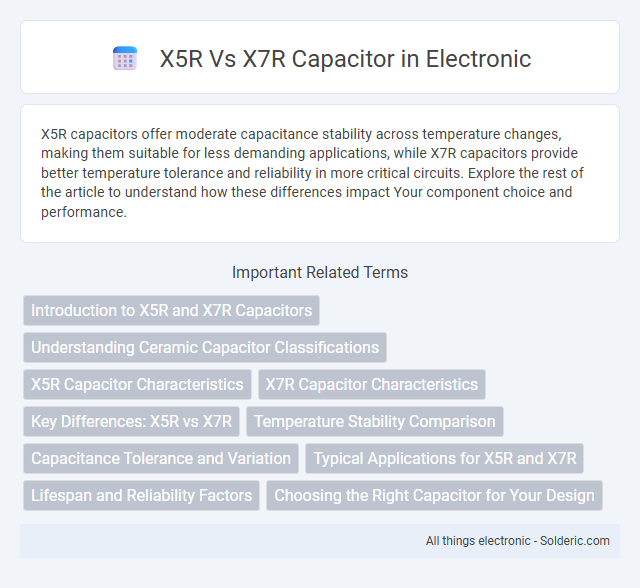X5R capacitors offer moderate capacitance stability across temperature changes, making them suitable for less demanding applications, while X7R capacitors provide better temperature tolerance and reliability in more critical circuits. Explore the rest of the article to understand how these differences impact Your component choice and performance.
Comparison Table
| Feature | X5R Capacitor | X7R Capacitor |
|---|---|---|
| Temperature Range | -55degC to +85degC | -55degC to +125degC |
| Temperature Coefficient | +-15% capacitance change | +-15% capacitance change |
| Dielectric Material | Barium Titanate Ceramic | Barium Titanate Ceramic |
| Capacitance Stability | Moderate | Better than X5R |
| Applications | General purpose, lower temperature environments | Higher temperature, automotive, industrial |
| Voltage Rating | Rated typically up to 50V | Rated typically up to 50V |
| Cost | Lower cost than X7R | Higher cost due to stability |
Introduction to X5R and X7R Capacitors
X5R and X7R capacitors are popular ceramic capacitors classified under Class II dielectric materials, commonly used for their balance of capacitance and stability. X5R capacitors operate efficiently within a temperature range of -55degC to 85degC, while X7R capacitors offer wider temperature performance from -55degC to 125degC, making them suitable for more demanding applications. Your choice between X5R and X7R depends on the temperature stability requirements and capacitance tolerance needed for reliable circuit performance.
Understanding Ceramic Capacitor Classifications
X5R and X7R capacitors are both popular types of ceramic capacitors commonly used in electronic circuits for their stability and reliability. X5R capacitors operate within a temperature range of -55degC to 85degC and maintain capacitance within +-15%, while X7R capacitors function from -55degC to 125degC with the same capacitance tolerance, making X7R more suitable for higher temperature environments. Your choice between X5R and X7R should be based on the temperature requirements and stability needs of your specific application to ensure optimal performance.
X5R Capacitor Characteristics
X5R capacitors exhibit a dielectric temperature range of -55degC to 85degC with a capacitance tolerance typically around +-15%, making them suitable for general-purpose applications requiring moderate temperature stability. These ceramics use a barium titanate base material, providing higher capacitance values per volume compared to C0G/NP0 types, but with noticeable capacitance variation under voltage and temperature stress. X5R capacitors balance cost and performance effectively in decoupling, filtering, and bypass tasks where strict precision is not critical.
X7R Capacitor Characteristics
X7R capacitors offer a stable capacitance variation of +-15% within a temperature range of -55degC to 125degC, making them suitable for applications requiring moderate temperature stability. Their dielectric material provides higher voltage ratings and better performance under high stress compared to X5R capacitors, which operate up to 85degC with +-15% capacitance variation. Your choice of capacitor should consider X7R's enhanced reliability for circuits needing consistent capacitance across wider temperature ranges.
Key Differences: X5R vs X7R
X5R capacitors operate within a temperature range of -55degC to 85degC with a capacitance tolerance of +-15%, while X7R capacitors function from -55degC to 125degC with the same tolerance, making X7R more suitable for higher-temperature applications. Both types offer stable capacitance and reliable performance in decoupling and filtering, but X7R capacitors generally exhibit better capacitance retention over temperature variations. Choosing X7R capacitors ensures your circuits maintain performance under harsher thermal conditions compared to X5R options.
Temperature Stability Comparison
X7R capacitors offer better temperature stability than X5R, maintaining capacitance within +-15% across a broader range (-55degC to +125degC) compared to X5R's +-15% from -55degC to +85degC. This makes X7R capacitors more suitable for applications requiring consistent performance in higher or more variable temperatures. Understanding this difference helps you select the optimal capacitor for temperature-sensitive electronic circuits.
Capacitance Tolerance and Variation
X7R capacitors typically offer tighter capacitance tolerance, often +-15%, compared to X5R capacitors that also have a +-15% tolerance but exhibit greater variation under temperature changes. X7R capacitors maintain more stable capacitance across a wider temperature range (-55degC to 125degC), whereas X5R capacitors operate optimally between -55degC and 85degC but experience more significant capacitance shifts. The enhanced stability of X7R types makes them preferable for precision circuits requiring consistent capacitance despite temperature fluctuations.
Typical Applications for X5R and X7R
X5R capacitors are commonly used in applications requiring stable capacitance over a moderate temperature range, such as decoupling in consumer electronics and power supply filtering. X7R capacitors offer improved temperature stability and reliability, making them suitable for automotive electronics, industrial equipment, and high-performance computing devices. Both types are favored for their balance of capacitance density and voltage rating in surface-mount technology (SMT) applications.
Lifespan and Reliability Factors
X7R capacitors generally offer better lifespan and reliability compared to X5R capacitors due to their wider temperature rating of -55degC to +125degC, which reduces performance degradation under thermal stress. X7R capacitors maintain capacitance within +-15% over this broader temperature range, enhancing stability and durability in high-temperature environments. In contrast, X5R capacitors operate effectively between -55degC and +85degC but tend to experience faster capacitance loss and aging, impacting long-term reliability in demanding applications.
Choosing the Right Capacitor for Your Design
X7R capacitors offer improved temperature stability and lower capacitance variation compared to X5R, making them ideal for applications requiring consistent performance across a wider temperature range from -55degC to +125degC. X5R capacitors work well in designs where cost-efficiency is critical and temperature variation from -55degC to +85degC is acceptable, despite their higher capacitance tolerance of +-15%. Selecting the right capacitor depends on your design's temperature requirements, stability needs, and budget constraints to ensure optimal circuit functionality and reliability.
X5R vs X7R capacitor Infographic

 solderic.com
solderic.com